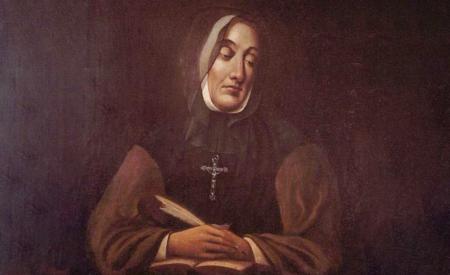Celebrating the Legacy of St. Marguerite d'Youville on her Feast Day
The feast day of St. Marguerite d'Youville, foundress of the Grey Nuns and the first Canadian-born saint is Oct. 16 and this year marks the 25th anniversary of her canonization. St. Marguerite's legacy is significant to many, but especially to the Grey Nuns, who have established a wide network of health and elder care organizations throughout New England, and who continue to live their lives in her spirit.
A poor widow at the age of 30, Marguerite d'Youville challenged the class boundaries of her time, always advocating for the needs and rights of the most marginalized members of society. Her commitment to serving the poor was matched by a daring willingness to take on responsibilities rarely assumed by women of her class. Nowhere is this tenacity apparent than in the saga of her management of the General Hospital of Montreal.
The story begins with displacement. On Jan. 31, 1745, a house rented by Marguerite and three other pious women burnt to the ground. The women had formed a religious association that ministered to the sick and the poor. They had used the house to provide shelter for the needy as well as for themselves. They were known derisively as "soeurs grises," which means both "tipsy nuns" and "grey nuns" in French, because Marguerite was the widow of a bootlegger.
After the fire, the fledgling group of sisters spent years on the move, without a permanent home, until Marguerite was named temporary director of the General Hospital of Montreal. At the time, the hospital was in a state of neglect. Shattered windows, moldy wood, broken doors and collapsing infrastructure were among the challenges facing Marguerite when she moved in. According to "A Journey of Love: The Life Story of St. Marguerite," by Sister Marie Cecilia Lefevre, SGM and Sister Rose Alma Lemire, SGM, Marguerite's temporary appointment as hospital director was "a last resort, as no one could be found to administer this neglected institution... . At that time, four elderly men and two aged religious brothers were living at the hospital under deplorable conditions. After attending to their urgent needs, Marguerite's creative ingenuity and the energetic activity of her sisters soon made the house livable."
Marguerite and the sisters breathed new life into the hospital. They raised funds for much needed renovations and were soon able to care for more patients.
In 1750 the hospital faced an external threat. Authorities deemed that the General Hospital in Montreal was superfluous, and should be merged with a hospital in Quebec. Fearing that this would mean the displacement of many of her patients, Marguerite inspired influential members of the community to protest the ordinance. By this time, her transformation of the General Hospital and her many additional works of charity had begun to earn Marguerite a reputation around town. With the support and intervention of Sulpician priests, the ordinance was appealed to the Royal Court in France (Canada was still a French territory) and finally overturned in 1752.
This legal decision helped solidify the influence and legacy of Marguerite and the Grey Nuns of Montreal. Prior to the controversy, the Grey Nuns were a self-assembled religious group without official standing, and their management of the hospital was seen as temporary. In 1753, in addition to appointing Marguerite as permanent "directress of the General Hospital of Montreal," King Louis XV of France signed Letters Patent that officially recognized the Sisters of Charity (Grey Nuns). The Bishop of Quebec granted canonical approval to the Grey Nuns a year later.
As if their previous challenges with the General Hospital had not been enough, on May 18, 1765, a massive fire completely destroyed the hospital. At the age of 64, Marguerite began the formidable tasks of rebuilding her hospital from the ground up. Donations flowed in from those she had inspired, including her sisters, the Sulpician priests, and a group of Native Americans to whom she had provided care during a smallpox epidemic. By the time of her death at the age of 70, she had rebuilt the hospital and was ministering to 170 dependents.
Marguerite's management of the General Hospital of Montreal, in the face of one obstacle after another, is an inspiring example of her unflagging energy. Today, the hospital is a National Historic Site in Canada, known as the Grey Nuns' Hospital. In 1990, Pope John-Paul II canonized Marguerite d'Youville, making her the first Canadian to become a saint. Her legacy is carried on by an expansive network of Catholic and interfaith organizations, ranging from small volunteer organizations to large hospitals. The Grey Nuns in New England have long held their administrative offices at Youville Place Assisted Living in Lexington, and many also reside at Youville Place. In honor of St. Marguerite's Feast Day, they have planned a eucharistic celebration at the Youville Place Chapel.
ADAM JOHNSON WRITES FOR YOUVILLE ASSISTED LIVING RESIDENCES, MEMBER OF COVENANT HEALTH SYSTEMS, A CATHOLIC, MULTI-INSTITUTIONAL HEALTH AND ELDER CARE ORGANIZATION SERVING NEW ENGLAND.
- Adam Johnson writes for Youville Assisted Living Residences, member of Covenant Health Systems, a Catholic, multi-institutional health and elder care organization serving New England.



















